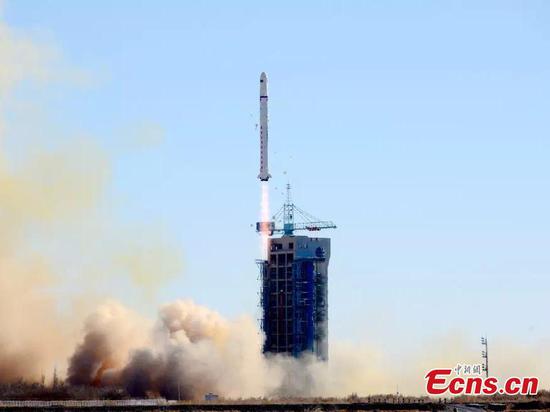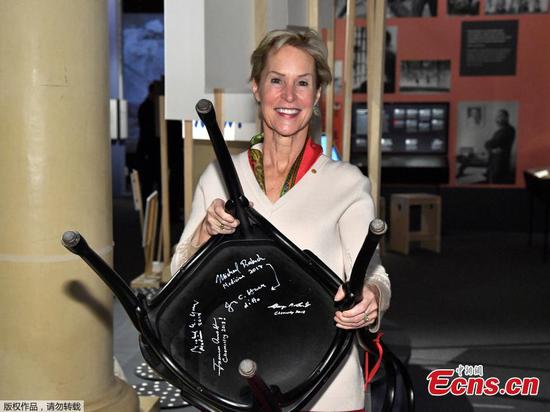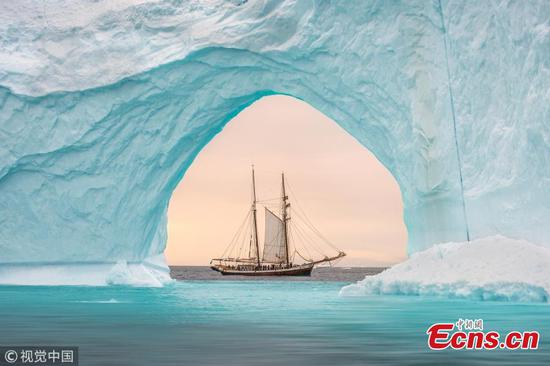![An artist's rendering of China's 135,000-metric ton Vista-class cruise ship. [Photo provided to China Daily]](http://image.cns.com.cn/ecns_editor/transform/20181210/MPAl-fzanvsu6055759.jpg)
An artist's rendering of China's 135,000-metric ton Vista-class cruise ship. [Photo provided to China Daily]
Travel industry, public sector step up moves to boost marine-based tourism
If a friend from abroad were to materialize suddenly in China as a tourist, the question "Gee, when did you land" will likely pop up from the presumption that he or she flew into the country. But, if some tourism firms' plans fructify, there might soon be an alternative question: "Hey, when did you make landfall?"
More and more tourists are expected to reach China by cruise liners from now on. And, as wanderlust grips experience-hunting Chinese middle-class travelers flush with rising disposable incomes and bitten by the consumption upgrade bug, the domestic tourism industry is expected to see a rapid growth of cruises, market insiders said.
According to the Cruise Lines International Association, by 2025, the number of Chinese travelers who will have experienced cruise trips is expected to grow to 8 to 10 million.
That would mark a surge from about 2.5 million Chinese travelers, or less than 2 percent of China's outbound global travelers, who took cruise trips last year.
An estimated 300 million Chinese consumers would be able to afford cruise trips in the near future.
"In the next 10 to 20 years, the number of Chinese who take cruise trips annually is expected to surpass that of the United States. Growth in the world's cruise market is expected to come from China," said Zheng Weihang, executive vice-president and secretary-general of the China Cruise & Yacht Industry Association.
"As the industry continues to grow and develop in the region, China is widely expected to eventually become the largest cruise market in the world."
Small wonder, moves are afoot at both governmental and corporate levels to harness all that potential.
Spanning modernization and upgrades of ports to home-built ships, purchase of ocean liners, multimodal transport mechanisms and longer duration visa-free visits to certain Chinese mainland areas in the neighborhood of ports, the big-ticket measures will seek to monetize multibillion-dollar opportunities.
Michael Thamm, CEO of Costa Group and Carnival Asia, spoke after parent Carnival Corp, the world's largest leisure travel company, announced a 40:60 joint venture with China State Shipbuilding Corp or CSSC in November. "We are here in China not only to operate ships, but to build the whole ecosystem, including shipbuilding, supply chain, port development, distribution, and destinations. We would like to contribute to building a cruise economy in China, putting into full play the multiplier economic effect."
Meanwhile, Shanghai plans to build the Wusongkou International Cruise Terminal, an integrated complex complete with duty-free shops comparable to those at its international airport.
And the products sold at the port's boutiques and in nearby areas will be upgraded. The idea is to boost coordinated growth of leisure cruises and city tourism, according to the local government.
The planned terminal will in itself be a potential tourist attraction, much better than the current port in Shanghai, where a solitary duty-free shop covers less than 500 square meters, and sells mainly cigarettes and liquor. For today's outbound and inbound cruise tourists, that wouldn't simply suffice.
Shanghai's local government therefore said in a statement issued in October that the planned terminal will house large-size duty-free stores that would stock top-end goods.
A campaign to spread awareness about China's various visa-free visit policies is also on the anvil. Unlike airline passengers, many foreign cruise travelers are not aware of China's 144-hour visa-free transit policy
International travelers from 53 countries can enter the Chinese mainland through the ports in Shanghai, Jiangsu province and Zhejiang province.
Publicity for visa-free policies can attract more inbound foreign tourists to enter China by cruises, the Shanghai government said in its statement.
South China's island province Hainan has also started a pilot run of its 15-day visa-free policy for tourist groups who take cruises and enter the country from ports in Hainan.
The plans for upscale cruise liner terminals are shaped by the commercial success of duty-free shops at key airports like the Shanghai Pudong International Airport, fueled by a constantly growing number of international travelers with strong spending power.
The airport said in its earnings report that income growth of non-aviation sector mainly comes from the growth of duty-free retail. Tourists spend not just on hotels, local travel, food and shopping at malls and other areas, but also at airports.
China is the world's top outbound tourism market. According to the United Nations World Tourism Organization, the country's 142 million outbound travelers spent an estimated $258 billion traveling abroad last year.
If they are encouraged to spend at home as well, and if more Chinese people are to travel, then new attractions like cruise trips and modern terminals at ports could prove a big draw.
So, Shanghai will encourage cruise operators and third-party agencies to further develop the domestic cruise tourism markets. Efforts are underway to introduce linkages between cruises, airlines, trains and buses, to enable multimodal transport for travelers.
In addition, the city will promote cruise tours at airports, train stations and other places with large passenger flows.
At the corporate level, CSSC Carnival Cruise Shipping Ltd, the China-based joint-venture cruise liner, will operate its own fleet to serve Chinese guests by the end of 2019.
It announced an agreement to purchase two existing ships from Carnival Corp's Costa Group, a major cruise operator in Europe and Asia.
The first of these ships, the Costa Atlantica, is scheduled to be transferred to the new Chinese cruise line by the end of 2019.
Currently, the Costa Atlantica mainly sails from southern China seaports like Shenzhen to Southeast Asian countries like Vietnam and the Philippines. The Costa Atlantica's sister ship, the Costa Mediterranea, will be transferred at a later date, according to the company.
Besides, the joint venture signed a contract to order two new cruise ships, the first China-built large cruise fleet.
The two new cruise ships will be constructed by Shanghai Waigaoqiao Shipbuilding Co Ltd, a State-owned shipyard in Shanghai. The first ship is expected to be delivered in 2023 to serve the Chinese cruise market.
The agreement also gives the joint venture the option to order four additional China-built cruise ships to serve the growing demand of Chinese consumers.
Thamm of Carnival Asia said: "As a large, dynamic and underpenetrated cruise market with continued long-term projections for outbound tourism growth, China represents a significant opportunity for the cruise industry to raise awareness, consideration and demand for cruise vacations in the coming years."
But the cruise industry in China faces a significant hiring challenge in the face of growing demand. By 2020, the talent gap in the sector will reach 280,000, according to the Cruise Lines International Association.
MSC Cruises, one of the major cruise lines with a dominant market share in Europe, South America and South Africa, entered the China market in 2010. The company said up to 2022, it needs 32,000 new crew members, including entry-level employees and mid-level managers.
The company said it is actively looking for partnerships with educational institutions in China, and would like to build a global network of MSC training academies.
It also said its crew members will be taught languages and be made eligible to serve in ships around the world, as per the company's staff rotation policy that covers its whole fleet.


















































